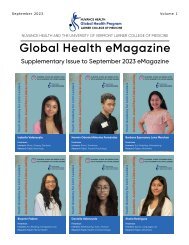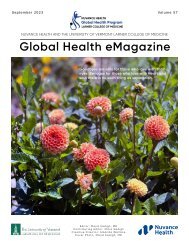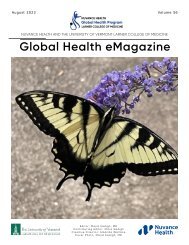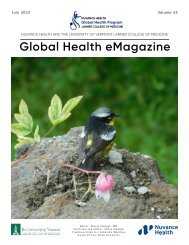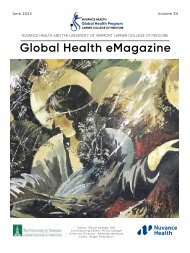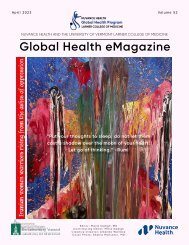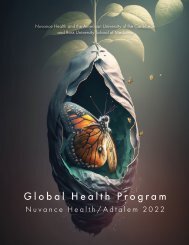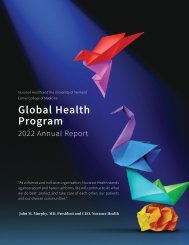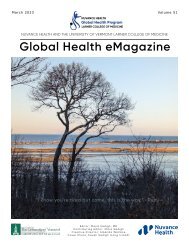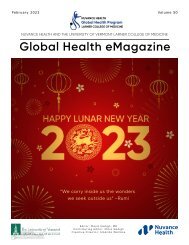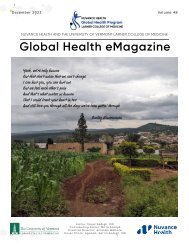eMagazine August 2022
Create successful ePaper yourself
Turn your PDF publications into a flip-book with our unique Google optimized e-Paper software.
OUR PEOPLE,<br />
OUR MISSION<br />
Global Health<br />
<strong>eMagazine</strong><br />
<strong>August</strong> <strong>2022</strong><br />
Highlights<br />
Clinical Case of the Month<br />
Reflections<br />
Health Disparities Within Our<br />
Borders<br />
Nursing Division<br />
Art to Remind Us of Who We<br />
Can Be<br />
Our Beautiful Planet<br />
Among the Letters<br />
Congratulations<br />
Global Health Team<br />
Calendar<br />
Resources<br />
Congolese artifact. Together, they went to Times Square and ate Big Macs. Then,<br />
donning winter outerwear, they took the train to New Haven. They had been<br />
invited to address a tropical-forestry conference at Yale, a gathering that brought<br />
together, among others, a Puerto Rican ecologist, a Uruguayan photojournalist, a<br />
Kenyan agriculturist, an Indonesian lawyer, and a Malagasy lemur conservationist.<br />
Tamasala and Kasiama are founding members of the Congolese Plantation Workers<br />
Art League (C.A.T.P.C., as its initials are rendered in French), an artists’ collective<br />
established in 2014 with grand, sometimes surreal-sounding ambitions. Aided by<br />
images projected onto a screen behind him, Tamasala described the group’s work,<br />
which is informed by the legacy of a former palm-oil plantation, once owned by the<br />
giant consumer-goods company Unilever, where many of them lived.<br />
A convoluted schematic appeared on the screen; many arrows were involved.<br />
Tamasala explained that corporations such as Unilever have used the profits<br />
from plantation labor in Africa to fund the cultural enrichment of wealthy Western<br />
populations. A photograph of depleted farmland dissolved into a Pre-Raphaelite<br />
painting of the sort collected by the founder of what would become Unilever.<br />
“Nothing of all this investment goes back to the plantations,” Tamasala said. “It<br />
doesn’t benefit the place where the money comes from.”<br />
Explaining that the Lusangans “had thought about this situation and about how<br />
we might detach ourselves from its grip,” he described the C.A.T.P.C.’s sly, absurdist<br />
approach. The collective, which is made up of some thirty local artists of all ages,<br />
creates figurative sculptures using river clay, which are then scanned in 3-D. The<br />
files are sent to Amsterdam, where they are cast in chocolate, which until recently<br />
most members of the C.A.T.P.C. had never tasted, despite the fact that many of<br />
them harvested the ingredients from which it is made. The finished sculptures—<br />
technically edible, symbolically fraught—are sold in art galleries, mostly in Europe.<br />
With the proceeds from their art work, and with help from a European nonprofit,<br />
the coöperative buys back land—more than two hundred acres so far—and farms it<br />
using ecological methods, to replenish soil devastated by Unilever’s monocultural<br />
farming techniques. The C.A.T.P.C. calls the project a “post-plantation.”<br />
The process, with its dreamlike logic, has transformed life in Lusanga. Plantation<br />
workers there earn twenty or thirty dollars a month; as artists, they make much<br />
more. The collective has brought in more than a hundred thousand dollars since its<br />
creation, and it has had shows in cities including Berlin, Warsaw, Amsterdam, Tokyo,<br />
New York, Copenhagen, and Jeddah.<br />
Tamasala showed a photograph of a man working on a sculpture. “Here you’ll<br />
recognize my colleague Mathieu,” he said, and smiled at Kasiama, who had<br />
remained seated. Kasiama appeared in one of the following images as well—a<br />
portrait accompanying a rave review in the Times of a 2017 C.A.T.P.C. exhibition at<br />
SculptureCenter, in Queens.<br />
Read the Article:<br />
Can an Artists’ Collective in Africa Repair a Colonial Legacy<br />
https://www.newyorker.com/magazine/<strong>2022</strong>/07/25/can-an-artists-collective-inafrica-repair-a-colonial-legacy<br />
19<br />
19





